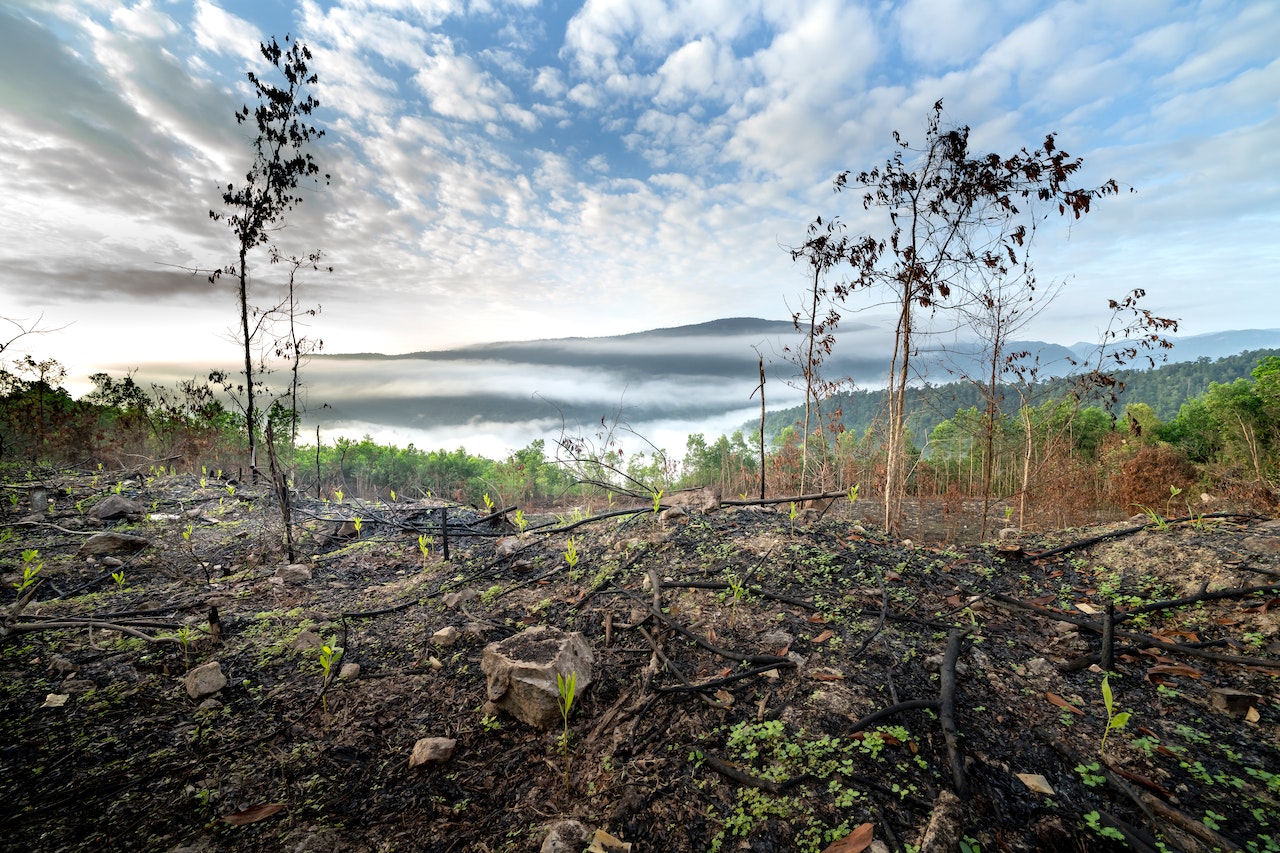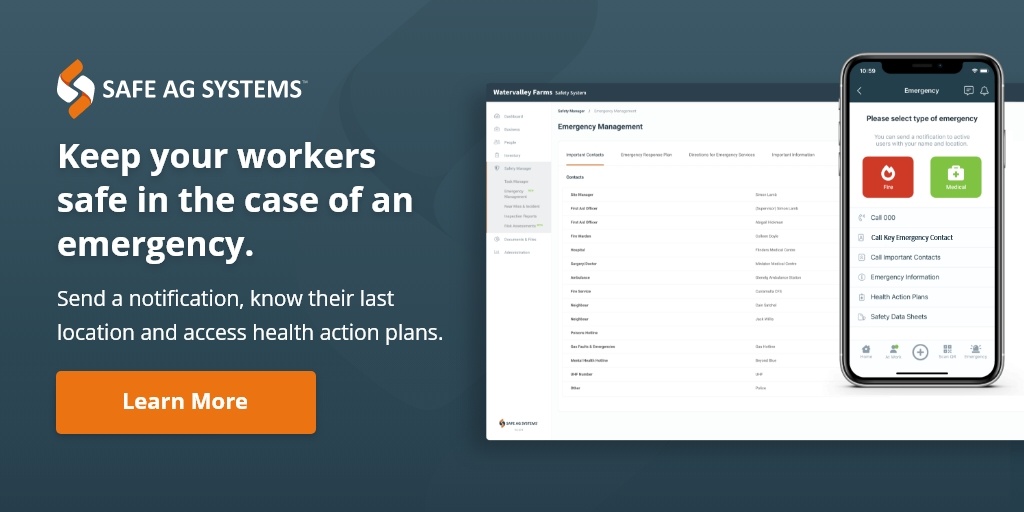As we near the seeding season for agricultural farms, it's a great time to get everything sorted out for a safe and successful kickoff to the season.
Harvest is approaching so too is fire season, that means high ambient temperatures, humidity and winds, dry stubble and hot exhausts and machine parts. A great combination for harvester and paddock fires unless you’re prepared and ready. So, its time to look at fire safety on-farm.
There are a few easy things you can do to minimise the risk of fire during harvest.
1. Have a plan
You will probably already have an emergency plan in place, which lets people know what to do in the event of a fire, medical emergency or another emergency. This will include a list of emergency contacts which people can find quickly and easily.
Spend time with your people before harvest starts and go through the plan, with an emphasis on fire safety. Decide how you will raise the alarm if a fire does break out, how you will communicate throughout the incident, who will contact fire services and authorities, and what each person needs to do.
Don’t be too shy to do a fire drill and practice what to do. Better to muck something up in a drill than when the emergency is real.
Make sure your property name or number is clearly visible so emergency services can identify it easily when approaching the entrance. Most importantly, have a routine in place for fire risk days (moving stock and limiting or postponing machinery use, switching off electric fences). Make sure everyone on your property is aware of it.
2. Prepare your machinery
Make sure you’ve done your pre-harvest inspection and maintenance. Check over everything, replace any parts that look worn, ensure bearings are well greased. Well-maintained equipment is much less likely to have machinery failure, a common cause for starting a farm fire. It’s also less likely to break down causing frustrating delays. For bearings which are failure-prone, have spares on hand and where possible, change them before the bearing collapses.
Consider installing exhaust system shielding treatments. Just a word of caution - before installing any exhaust insulation blankets, check this doesn’t cause any warranty implications.
Check spark arrestors on machinery are working and efficient. Avoid use of petrol vehicles in paddocks or use extreme caution when driving into stubble. Try to keep the exhaust of a petrol vehicle in the wheel tracks to limit contact with straw.
.jpg?width=1280&height=853&name=pexels-bekir-umut-vural-14063323%20(1).jpg)
3. Check the conditions
Throughout the day, keep an eye on the conditions. Factors that contribute to farm fires include relative humidity, ambient temperature, wind, and crop type and conditions. Stop when the danger is extreme. On high fire danger days, use a fire danger index like the one published by the GRDC to determine when things are getting too risky to continue work. If the fire danger index approaches 35, it’s time to stop.
Limit or cease harvest operations on Severe, Extreme or Code Red/Catastrophic Fire Danger Days.
4. Monitor hot spots and clean down regularly
Keep a regular check on bearings (use a handheld infrared thermometer to monitor temperature on bearings, brakes and other hot parts), belts, hydraulic lines and dust trap areas. Look for rubbing or slipping belts. Check spots where chaffing can occur like fuel lines, battery cables, hot wires, tyres, drive belts, etc.
It’s not always noticeable from the cab if smoke or fire is coming from some parts of the harvester. Have a walk around every time you stop and pay attention to the hot spots.
Keep the harvester free of dust and chaff accumulation especially around the manifold, turbocharger or exhaust system. Have an air compressor handy to blow accumulation off the machine at regular intervals, and check accumulation points every time you exit the drivers’ seat. A few minutes cleaning the machine off could save your harvester and your crop. Lentil and pulse crops are renowned for dust build up and are more volatile than cereal crops so extra care is needed when harvesting these.
Depending on the crop, a blow-down may be required every boxful. Start on the front and move to the top, working down from there. Clean down regularly.
Don’t overload electrical circuits. Blown fuses should only be replaced with the same amperage wire, not a higher one as this will override protection from shorts and overloading.
Drag chains, drag cables or grounding conductors may help dissipate electrical charge but aren’t going to work in all conditions.

5. Have firefighting equipment on hand
In addition to having a fire extinguisher on the harvester, have a firefighting unit in the paddock you’re harvesting. This might be a slip-on or a tanker, depending on the nature of your fire risk. Tanks must hold at least 1000L of water, plus a water (red) and ABE (white band) fire extinguishers on the harvester are considered a minimum. You could have a knapsack of 9L or more as well. Make sure the tank is full, the pump is in good working order and everyone knows how to operate the unit.
Prepare for an emergency and have rakes and shovels handy to help with firefighting efforts.
Fire suppression systems can be fitted to most harvesters and given the cost of a new machine, plus potential crop losses, this in an investment worth considering.
6. Managing a fire
If a farm fire does break out, pull the machine out of the crop as quickly and safely as you can, face it into the wind and get out. A harvester can be replaced. People can’t. Make sure you put personal safety before all else.
Call your local authorities. Enact your Emergency Plan. Use the equipment you’ve got on hand to fight the fire. If it gets too much for you or gets away in the crop, evacuate to a safe place.
With the right preparation, you might just avoid a fire breaking out this season. If it does, being prepared puts you in a much better position to limit any damage.
Disclaimer: Content on this website may be of relevance to users outside of Australia, but content links and examples are specific to Australia. Please check with your local authority for your country and industry requirements.












